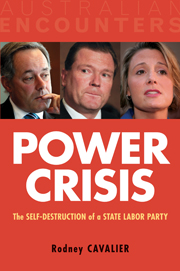Book contents
- Frontmatter
- Contents
- Australian Encounters with the ALP
- Preface
- Acknowledgements
- Introduction
- 1 NSW Labor and its leaders
- 2 Death below
- 3 The rise of Morris Iemma
- 4 Annual Conference, May 2008
- 5 Morris Iemma falls
- 6 The protracted fall of Nathan Rees
- Epilogue: Does party membership matter?
- Appendix A NSW ALP branches closed 1999–2009
- Appendix B NSW ALP financial membership 2002–09
- Appendix C Delegates to NSW ALP Annual Conference, May 2008
- Sources
- Index
- Australian Encounters series
- Forthcoming titles in the Australian Encounters series
1 - NSW Labor and its leaders
Published online by Cambridge University Press: 10 January 2011
- Frontmatter
- Contents
- Australian Encounters with the ALP
- Preface
- Acknowledgements
- Introduction
- 1 NSW Labor and its leaders
- 2 Death below
- 3 The rise of Morris Iemma
- 4 Annual Conference, May 2008
- 5 Morris Iemma falls
- 6 The protracted fall of Nathan Rees
- Epilogue: Does party membership matter?
- Appendix A NSW ALP branches closed 1999–2009
- Appendix B NSW ALP financial membership 2002–09
- Appendix C Delegates to NSW ALP Annual Conference, May 2008
- Sources
- Index
- Australian Encounters series
- Forthcoming titles in the Australian Encounters series
Summary
Competition for power is the natural condition of political activity. At its first electoral outing in 1891, Labor won seats in large numbers – 35 seats on debut, an arrival not matched by the Country Party, One Nation, nor any other political force in all the years since. Seats won and held acquired status as ‘safe’, impregnable fortresses akin to the property of the party, the most valuable of spoils there for the taking. Or giving. Labor endorsement was tantamount to winning the seat. With payment of MPs and the achievement of government, membership of Parliament via ALP endorsement became an entrée to power and a glittering life. Men would do almost anything to win that prize. So, it has proven, will women.
The people in charge of party administration – and those who challenge them – have believed their pre-eminent task to be the delivering of the prize of Parliament to themselves and their supporters. If the master plan for local preselection required support in the higher levels of the party, the master plan warranted such an amendment. Preselection battles have echoed wider struggles for control of the administration and the right to write the rules of conflict; those wider struggles were preludes to the right to dominate the preselection process. Every serious schismatic struggle in the ALP is about determining who gets to select who goes into Parliament.
- Type
- Chapter
- Information
- Power CrisisThe Self-Destruction of a State Labor Party, pp. 5 - 30Publisher: Cambridge University PressPrint publication year: 2010



